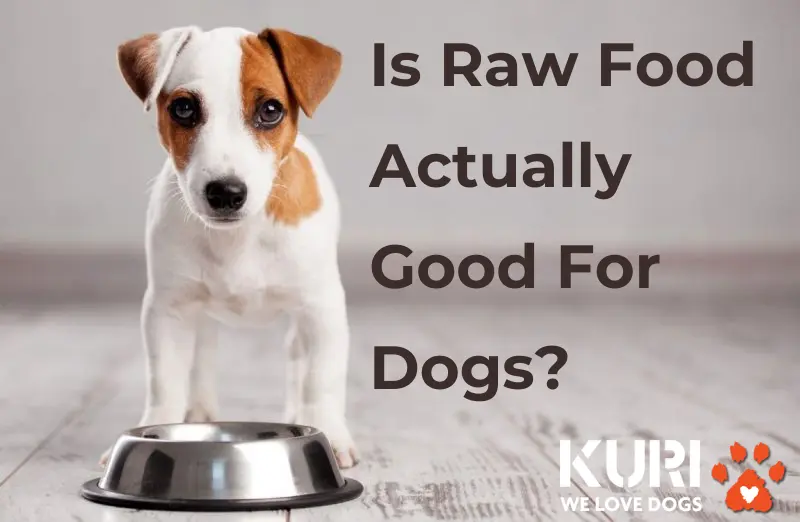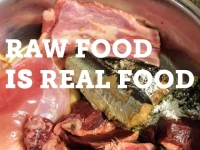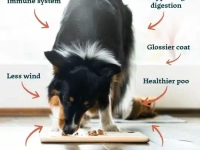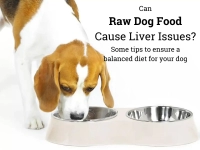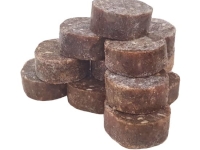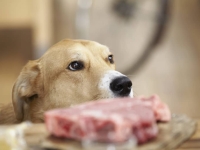In This Article...
THE OVERVIEW...
The food choices for our four-legged companions have grown significantly recently. With a 86% increase in the sale of fresh food for dogs in the last 2 years. Among the options of diets available, the raw food movement has carved out a niche due to an increasing number of dog owners wanting to give their dog a diet more suited to their needs. As this trend gains traction, understanding the how to get started feeding raw food to dogs becomes essential. What are the benefits? What risks lurk beneath the surface? What are some things to look out for?
What is Raw Dog Food?
Raw dog food, often abbreviated as BARF (Biologically Appropriate Raw Food) or the Prey Diet, primarily consists of uncooked meat and bones. The BARF diet also includes fruits, and vegetables as a way of including the natural forage that dogs in the wild might have access to.. Both of these approaches are rooted in the belief that dogs thrive on a diet similar to that of their wild ancestors. Advocates argue that a raw diet mirrors the natural eating habits of canines, promoting optimal health and vitality.
The Benefits of Feeding Raw Food to Dogs
1. Nutritional Advantages
- High Protein Content: Raw food is rich in protein, which is vital for muscle development and overall health.
- Improved Digestion: Many owners report better digestion when switching their dogs to raw food, thanks to natural enzymes and fewer fillers.
- Healthier Skin and Coat: Raw diets often lead to shinier coats and healthier skin, a benefit attributed to the absence of artificial ingredients.
- Better Dental Health: Chewing raw bones can assist in maintaining dental hygiene, reducing plaque and tartar build-up.
- Reduced Poops: Owners notice a change to their dogs poop. Less frequent and firmer. This indicates that more of the nutrients are being absorbed by the body which is not often the case with kibble as it can be loaded with fillers and simple starches.
2. Enhanced Energy Levels
Many dog owners notice a boost in energy and vitality after transitioning their pets to a raw diet. With increased enthusiasm for walks and playtime, the positive impact on their overall quality of life is hard to overlook.
”Lots of our friends notice that Jessie is looking really healthy and her behavior has improved since we’ve switched her to raw food. Her skin, coat and overall weight has all improved”
The Risks of Raw Dog Food
1. Bacterial Contamination
Just like when you are managing raw meat for the humans in your family, raw dog food needs the same care. Only defrosting what you can use in the next couple of days and discarding food that looks off will help ensure that any risks are reduced. Pathogens like Salmonella and E. coli do pose potential threats but . Safe handling practices, such as proper storage and hygiene, are paramount.
2. Nutritional Imbalances
A poorly formulated raw diet can lead to nutritional deficiencies. It’s crucial to ensure that meals are well-balanced and meet the specific dietary needs of your dog. At Kuri our recipes are formulated to ensure that your dog is getting a mix of muscle, organ and bone in their meals.
3. Choking Hazards
Feeding bones can pose choking risks. Understanding which bones are safe and how to prepare them is essential for avoiding accidents. We recommend chicken necks for small dogs, veal bones for puppies and new bone chewers and beef necks for regular bones eaters.
Comparing Raw Food to Kibble
1. Nutritional Comparison
Kibble, while convenient, often contains preservatives, fillers, rancid fats and salt. Raw food, on the other hand, typically boasts higher nutritional value and in the case of Kuri Raw Dog Food; ZERO fillers!, It is important to note that your food choice largely depends on the dog’s individual needs.
2. Cost Analysis
The cost of raw food can be higher than kibble, but many owners view it as a long-term investment in their dog’s health. Quality ingredients often come at a premium, but the potential benefits may outweigh the initial expense. There is research suggesting that a change to raw food is extending the life of dogs and reducing the number of vet visits.
3. Convenience Factor
Kibble used to wins on convenience, requiring no preparation. Raw food from Kuri is cut into 90gm frozen medallions so that you can defrost just the amount you need. The writer of this article defrosts 2 days worth of raw food for his 2 dogs, keeping it in the fridge in a sealed container for safe keeping. It is also worth noting that you can feed the medallions as frozen enrichment, slowing your dog down and cooling them down on a hot day.
FAQs About Raw Dog Food
Is it better to cook raw dog food?
Cooking can eliminate pathogens but may reduce nutritional value. For dogs with specific health conditions, consulting a holistic veterinarian is wise.
Is raw dog food healthier than kibble?
Raw food can offer health benefits such as improved digestion and skin health. Each diet has pros and cons, and the best choice depends on your dog’s individual needs.
How much raw food should I feed my dog?
Generally, dogs should consume 2-3% of their body weight in raw food daily. For precise recommendations, consulting with a holistic vet is advisable or come into Kuri City
Do dogs prefer raw or cooked?
Dogs are naturally inclined towards raw food, but preferences can vary. Trying a range of recipes from Kuri and gradual introduction is key to gauging your dog's response.
Do vets recommend raw diet?
Opinions among veterinarians vary. While some endorse raw diets for their benefits, others warn of potential risks. Consulting a vet knowledgeable in raw feeding is crucial.
Expert Opinions on Raw Dog Food
Veterinarians and pet nutritionists offer a range of insights into raw feeding. Their perspectives can illuminate both the potential advantages and challenges associated with this diet. For well-rounded guidance, consider visiting reputable sources like Perfectly Rawsome.
Final Thoughts
Deciding whether to embrace raw dog food is a nuanced journey. Understanding the needs of your dog, weighing the benefits against potential risks, and consulting with professionals will guide your decision. For those considering this shift, visit Kuri for high-quality raw dog food options that can nourish your pet.
Share your experiences with raw feeding in the comments below, and let’s foster a community of informed pet owners eager to explore the best for their dogs.


